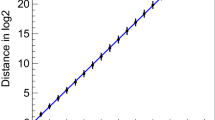Abstract
What do we want from a pseudo-random sequence generator? Ideally, we would like a pseudo-random sequence generator to quickly produce, from short seeds, long sequences (of bits) that appear in every way to be generated by successive flips of a fair coin.
The final version of this paper contains the proofs of all theorems discussed here. It will appear in the SIAM Journal of Computing.
This work was supported in part by the Letts-Villard Chair, Mills College.
This work was supported in part by NSF grant MCS 82-04506.
This work was supported in part by NSF grant MCS 82-01287.
Access this chapter
Tax calculation will be finalised at checkout
Purchases are for personal use only
Preview
Unable to display preview. Download preview PDF.
Similar content being viewed by others
References
L. Adleman, “On Distinguishing Prime Numbers from Composite Numbers,” Proc. 21st IEEE Symp. on Found. of Comp. Science (1980), 387–408.
M. Blum, “Coin Flipping by Telephone,” in Proc. of IEEE Spring COMPCON (1982), 133–137.
M. Blum and S. Micali, “How to Generate Cryptographically Strong Sequences of Pseudo Random Bits,” submitted to FOCS 1982.
G. Brassard, “On computationally Secure Authentication Tags Requiring Short Secret Shared Keys,” in Conf. Proc. Crypto 82, 1982.
L. Dickson, “History of the Theory of Numbers,” Chelsea Pub. Co., 1919 (republished 1971 ).
S. Even, “Graph Algorithms,” Computer Science Press, 1979.
C. G. Gauss, “Disquisitiones Arithmeticae,” 1801; reprinted in English transi. by Yale Univ. Press, 1966.
S. Goldwasser and S. Micali, “Probabilistic Encryption and How to Play Mental Poker Keeping Secret all Partial Information, ” 14th STOC (1982), 365–377.
S. Golomb, “Shift Register Sequences,” Aegean Park Press (1982).
D. Knuth, “The Art of Computer Programming: Seminumerical Algorithms,” Vol. 2, Addison-Wesley Pub. Co., 1981.
W. LeVeque, ‘Fundamentals of Number Theory,“ Addison-Wesley Pub. Co., 1977.
G. Miller, “Riemann’s Hypothesis and Tests for Primality,” Ph.D. Thesis, U.C. Berkeley (1975).
J. Plumstead, “Inferring a Sequence Generated by a Linear Congruence,” submitted to FOCS 1982.
S. Pohlig and M. Hellman, “An Improved Algorithm for Computing Logarithms over GF(p) and Its Cryptographic Significance,” IEEE Trans. on Info. Theory, Vol. It-24, No. 1, (1978), 106–110.
M. O. Rabin, “Probabilistic Algorithm for Tesitng Primality,” J. No. Theory, Vol 12 (1980), 128–138.
M. O. Rabin, “Digital Signatures and Public-key Functions as Intractable as Factorization,” MIT/LCS/TR-212 Tech. memo, MIT, 1979.
A. Shamir, “On the Generation of Cryptographically Strong Pseudo-Random Sequences,” ICALP, 1981.
D. Shanks, “Solved and Unsolved Problems in Number Theory,” Chelsea Pub. Co., 1976.
J. von Neumann, “Various Techniques Used in Connection With Random Digits,” Collected Works, vol. 5, Macmillan (1963), 768–770.
A. Yao, “Theory and Applications of Trapdoor Functions,” submitted to FOCS 1982.
Author information
Authors and Affiliations
Editor information
Editors and Affiliations
Rights and permissions
Copyright information
© 1983 Springer Science+Business Media New York
About this paper
Cite this paper
Blum, L., Blum, M., Shub, M. (1983). Comparison of Two Pseudo-Random Number Generators. In: Chaum, D., Rivest, R.L., Sherman, A.T. (eds) Advances in Cryptology. Springer, Boston, MA. https://doi.org/10.1007/978-1-4757-0602-4_6
Download citation
DOI: https://doi.org/10.1007/978-1-4757-0602-4_6
Publisher Name: Springer, Boston, MA
Print ISBN: 978-1-4757-0604-8
Online ISBN: 978-1-4757-0602-4
eBook Packages: Springer Book Archive




